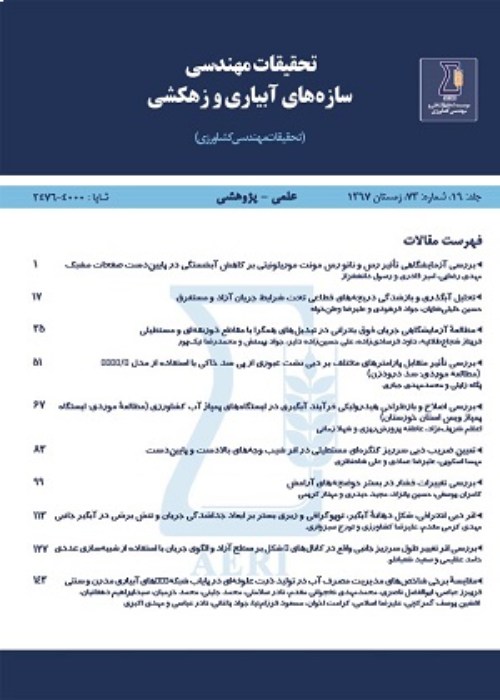Evaluation of Durability of Concrete lining in Irrigation Canals by Non-destructive Electrical Resistance Testing at Site
The durability of concrete is defined as its ability to resist weathering action, chemical attack, abrasion, or any other deterioration process to retain its original form, quality, and serviceability when exposed to harsh environment. To a large extent, it is commonly accepted that concrete durability is governed by concrete’s resistance to penetration of aggressive media. This media may be present in a liquid or gaseous state and that may be transported by various mechanisms such as permeation, diffusion, absorption, capillary suction, and combinations of the items just mentioned (Azarsa and Gupta, 2017).Over the last few decades, a great deal of attention has been paid to research and development of electrical resistivity measurement techniques as a nondestructive technique (NDT) to evaluate the durability of concrete structures. Irrigation canals are water structures that transport water supplied from supply sources, such as diversion dams, to the point of consumption for drinking or agricultural purposes. To prevent water seepage losses, the canals beds are lined with various materials such as concrete, stone and sandstone mortar, asphalt, etc. The use of concrete lining in irrigation canals has been more common in Iran and other countries than other materials. Concrete used in irrigation canals is non-reinforced with a thickness of 5 to 10 cm. The basic requirements for good concrete-lined in hardened state are satisfactory compressive strength and sufficient durability. After the implementation of any construction structure, in order to know the desired performance and quality of implementation, it is necessary to evaluate that project. To prevent water seepage in irrigation canals, most of them are lined with concrete materials. Destructive method of core sampling is often used to evaluate the quality of concrete lining in irrigation canals. This is a very costly and time consuming process and requires a great deal of specialized manpower and equipment, while the effects of core damage are not easily remedied. To evaluate executed concrete projects, they are often used using destructive methods and various laboratories are run on them in the laboratory. Although this method achieves relatively real and direct results from the desired parameters, it also has side effects that are sometimes difficult to compensate for. These include project damage, high costs, the need for extensive equipment and equipment, and time consuming, which can sometimes lead to downtime. To prevent these complications, non-destructive testing methods, which are much simpler, faster, and less expensive, can be used if there is evidence of correlation. These include electrical resistance testing, ultrasonic and Schmidt hammers. Today, non-destructive concrete experiments have a good and practical effect on the repair of concrete structures. Non-destructive concrete experiments, by providing various data on existing structures, allow experts and specialists to judge and decide on the performance, needs and methods of repair and reconstruction of concrete structures.
The criterion for evaluating the quality of concrete cover of irrigation canals in different environmental conditions, in practice, is the same as in non-water structures and concrete cover of irrigation canals in the country, the basis of which is the amount of compressive strength and technical criteria, respectively. It is published in 108 (Anon., 2014). In this publication, durable concrete is introduced as concrete that has a relatively high compressive strength and is executed correctly. In this study, in order to establish a relationship between non-destructive electrical resistance tests on site with the parameters of water absorption and compressive strength, which requires destructive testing for their achievement, 13 section from 7 main canals in different study basins were selected in Hamedan province. The electrical resistivity of concrete lining these sections was carried out by using of 4-point Wenner method. The Wenner probe technique was first introduced for the geologist’s field in order to determine soil strata by Wenner at the National Bureau of Standards in the 1910s and then modified through time for concrete application. In this technique, four equally spaced linear electrodes are used to measure the surface electrical resistivity of concrete (Figures 1 and 2). The two exterior electrodes apply an AC current to the concrete surface while the electrical potential is measured from the interior probes. It should be noted that DC current is not desirable as it may result in inaccurate readings because of polarization effect. About 12 cores from each canal and totally 156 cores were prepared. In the laboratory, the compressive strength, initial, boiling and capillary water absorption was measured and the relationships between the non-destructive electrical resistivity tests with each of the parameters of laboratory experiments on the cores were investigated.
Based on the results, it was found that only 3 of the concrete-lined canals were durable in the cold region and the remainder lacked durability. According to the results of the electrical resistivity values with the compressive strength, the correlation direct correlation of 87% is established, so that due to the non-destructive nature of the electrical resistivity test, it can be used to determine other durability and resistance parameters. The results also indicate that the other parameters of durability of the concrete lining in the studied irrigation canals include initial, boiled and capillary water absorption with a correlation coefficient of 87%, 89% and 85%, respectively, and an indirect exponential relationship with electrical resistance values.
Based on results of this paper, without destructive testing, all of these parameters can be estimated accurately by non-destructive 4-point electrical resistance testing and projects can be evaluated.
- حق عضویت دریافتی صرف حمایت از نشریات عضو و نگهداری، تکمیل و توسعه مگیران میشود.
- پرداخت حق اشتراک و دانلود مقالات اجازه بازنشر آن در سایر رسانههای چاپی و دیجیتال را به کاربر نمیدهد.



